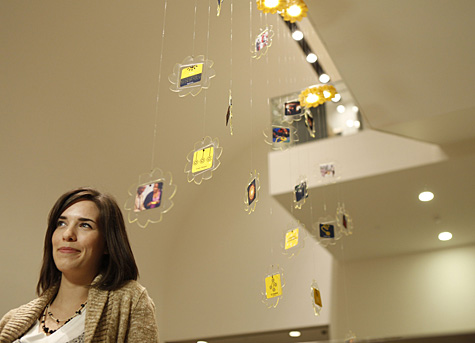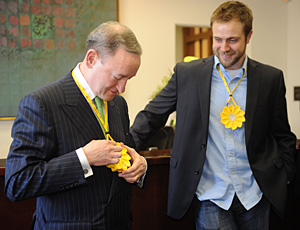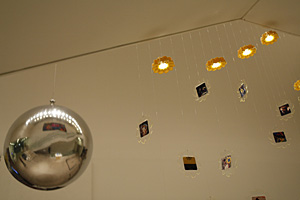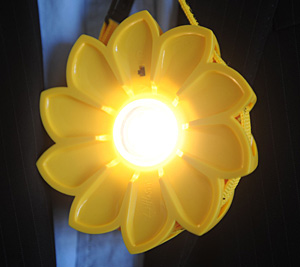
You try doing homework in the dark.
For school-aged children across much of the developing world, access to electrical lighting remains precarious. Many rural farming villages exist “off the grid.” Major cities from Nairobi to Kolkata are subject to regular blackouts — a phenomenon from which even the United States, as Hurricane Sandy demonstrated, is not entirely immune.
Enter the Little Sun. Designed by Danish artist Olafur Eliasson and engineer Frederik Ottesen, Little Sun is a small, powerful and inexpensive solar-powered lamp. The almost shockingly bright LED, encased in tough, cheerful yellow plastic, shines up to five hours on a four-hour charge.

“As an artist, Eliasson has increasingly turned his attentions to communities and peoples in need,” says Peter MacKeith, associate dean and associate professor of architecture in the Sam Fox School of Design & Visual Arts. “Can something of functional — almost desperate — value also become something of artistic consideration?”
Now Little Sun is at the center of two projects involving WUSTL students and faculty.
Sarah Moore, a master’s candidate in architecture, recently worked with MacKeith and Eliasson’s studio to design, construct and install a group of Little Suns in the Mildred Lane Kemper Art Museum.
Next spring, students in “Sustainable Development and Conservation: Madagascar”— offered by University College in conjunction with the Skandalaris Center for Entrepreneurial Studies and the Missouri Botanical Garden — will, among other projects, track the usage of Little Suns while exploring their larger economic and environmental potentials.
“Madagascar is a biodiversity hotspot, but only 10 percent of its forest is left,” explains Judi McLean Parks, the Taylor Professor of Organizational Behavior in the Olin Business School.
“The people are crushingly poor, among the poorest in the world,” adds McLean Parks. “When you’re faced with a starving child, you’ll cut down a tree to make charcoal to sell.
“You have to solve the people problem first.”
Transforming cultural production
In the Kemper Art Museum, the Little Sun installation is situated near another Eliasson project, the 600-pound aluminum sphere titled Your Imploded View, which hangs permanently in the atrium. The small yellow discs shine brightly in the latter’s mirror finish.
The installation is presented in conjunction with Design with the Other 90%: CITIES, a major exhibition of smart, problem-solving projects from around the world, which MacKeith coordinated. Alerted to the Little Sun by Sabine Eckmann, the museum’s William T. Kemper Director and Chief Curator, MacKeith arranged to meet Eliasson in September, during the Venice Architecture Biennale. He quickly saw the potential for wider university partnerships.

A collaborative effort
Next spring, that endeavor will expand off the southeastern coast of Africa, thanks to The Madagascar Project.
Founded in 2006 — in partnership with the Missouri Botanical Garden’s Community Conservation Program, which has been active in Madagascar for decades — the program helps small communities cultivate sustainable economic growth.
“It’s been a collaborative effort,” says Ken Harrington, managing director of the Skandalaris Center. He credits Charles McManis, JD, the Thomas and Karole Green Professor of Law, with bringing the garden’s outreach to university attention.
“Over the last several years, students and faculty from across campus have worked together on a wide variety of projects,” Harrington says. “Their ability to look at challenges from different disciplines has enriched the solutions and the experience for all involved.”

In January, the program will work with local conservation partners to dispense more than 100 Little Suns to families, farmers, basket-weavers and others. In May, students will travel to Madagascar, interview recipients and, hopefully, develop a sustainable business model to promote wider adoption.
“One of the challenges is how to define the process of distribution,” says adjunct instructor Armand Randrianasolo, PhD, associate curator at the Missouri Botanical Garden, who will teach the course. Given the limited number initially available, careless dissemination could lead to conflict between families or communities.
“We have to think carefully,” he says.
Yet the potential benefits are significant.
“First, it can enhance daily productivity,” Randrianasolo says.
For example, a busy mother might have only a few daylight hours each week for weaving baskets. Extra hours following dinner would result in more baskets to sell and more household income.
The lamp also will help families save money on candles and kerosene whose fumes can cause respiratory problems. That, in turn, can help alleviate the tension between economic and environmental stability.
“When the family has more income,” Randrianasolo concludes, “it won’t need to cut forest trees to feed the kids.”
At noon Thursday, Dec. 6, Judi McLean Parks will discuss Design with the Other 90%: CITIES at the Kemper Art Museum. In addition, at 5 p.m. the Skandalaris Center will host an open house, also in the Kemper Art Museum. Anne Dohmen and Ian Smith, both students in The Madagascar Project, will present posters about their work.
Both events are free and open to the public. For more information, call (314) 935-4523.